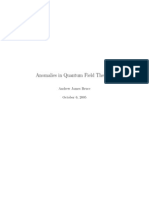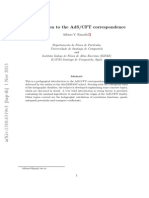Statistical Thermophysics, Robertson
Statistical Thermophysics, Robertson
Uploaded by
Yan-Tung LinCopyright:
Available Formats
Statistical Thermophysics, Robertson
Statistical Thermophysics, Robertson
Uploaded by
Yan-Tung LinOriginal Description:
Copyright
Available Formats
Share this document
Did you find this document useful?
Is this content inappropriate?
Copyright:
Available Formats
Statistical Thermophysics, Robertson
Statistical Thermophysics, Robertson
Uploaded by
Yan-Tung LinCopyright:
Available Formats
Canonical Systems 117
where the index n enumerates the states of the composite system and Ecn is the energy
when the system is in state n. Any state counted in Zc must be an identifiable combination
state of the composite system and not an alternative or incomplete representation of an
improperly defined composite state.
As an illustration, suppose Z 1 and Z2 in Eqs.(3.3.12) and (3.3.13) have just three states
each; let
Then the composite Z 12 of Eq. (3.3.15) becomes
or
Z12 = a1b 1 + a1b2 + a1b3 + a2 b1 + a2 b2 + a2b3 + a3b 1 + a3b2 + a3b3,
for nine composite states. But if the subsystems are identical and indistinguishable, then
ai = bi and the nine terms can be written as ai + 2a 1 a2 + a� + 2a1a3 + a� + 2a2 a3. A term
such as 2a 1 a2 arises as a1b2 + a2 b1, with ai = bi. In quantum theory, however, the state
of the system, is properly described as a two-particle state with states 1 and 2 occupied,
but by particles with no individuality, so it cannot be said that one particle is in state 1
and the other in state 2. The formalism says that each particle is in both single-particle
states, and that therefore only one such state exists. (This point is discussed further in the
commentary of this chapter, in Chapter 4, and in Appendix C.) Thus the proper partition
function should be
Zc = ai + a1a2 +a�+a 1 a3 +a;+a2 a3,
with only six (single) terms, rather than nine (counting the double ones).
If, instead of two such systems, there are N, then the function corresponding to zf is
which generates the number of permutations of N elements into three groups, where
I:
( N; m 1, m 2, m3) is the multinomial coefficient and mi = N. The proper partition function
should be simply
L a;:n 1 a;1 2 a-;i3 , again with L mi= N,
m1,m2,m3
but such a thing is difficult to write for a general partition function with an infinite number
of energy levels. However, when the number of levels becomes infinite, (or much larger than
N) the single-system partition function to the Nth power will still be of the form
(3.3.16)
with I,::,1 mi N. Evidently, then, most of the mi will be zero, and the largest terms
in Eq. (3.3.9) are those for which all the mi are 1 or 0. This is just the regime for which
You might also like
- The Lord's Prayer OutlineDocument7 pagesThe Lord's Prayer Outlinemaddogyp100% (2)
- Clark Robinson - Dynamical Systems - Stability, Symbolic Dynamics, and Chaos 2nd Edition (Studies in Advanced Mathematics) - CRC Press (1998)Document522 pagesClark Robinson - Dynamical Systems - Stability, Symbolic Dynamics, and Chaos 2nd Edition (Studies in Advanced Mathematics) - CRC Press (1998)laura.embusNo ratings yet
- 978 94 007 5410 2Document742 pages978 94 007 5410 2falsename306No ratings yet
- Malcolm P. Kennett - Essential Statistical Physics 2020Document263 pagesMalcolm P. Kennett - Essential Statistical Physics 2020seneca76No ratings yet
- The Physics of Nanoelectronics, First Edition, Tero T. Heikkilä, © Tero T. Heikkilä 2013Document288 pagesThe Physics of Nanoelectronics, First Edition, Tero T. Heikkilä, © Tero T. Heikkilä 2013Miloš DražićNo ratings yet
- Solutions V 1.2Document383 pagesSolutions V 1.2hdiazadasmeNo ratings yet
- (Arno Bohm (Auth.) ) Quantum Mechanics Foundations (B-Ok - Xyz)Document610 pages(Arno Bohm (Auth.) ) Quantum Mechanics Foundations (B-Ok - Xyz)Assis Rocha100% (1)
- Maggiore M. A Modern Introduction To Classical Electrodynamics 2023Document466 pagesMaggiore M. A Modern Introduction To Classical Electrodynamics 2023rvpilotNo ratings yet
- Monica Lewinsky and ShameDocument26 pagesMonica Lewinsky and ShameTracy EverbachNo ratings yet
- An Introduction To Gauge Theories 1st Ed by Cabibbo, Maiani and Benhar PDFDocument321 pagesAn Introduction To Gauge Theories 1st Ed by Cabibbo, Maiani and Benhar PDFkevinchu021195No ratings yet
- Henriette Elvang, Yu-Tin Huang - Scattering Amplitudes in Gauge Theory and Gravity-Cambridge University Press (2015) - 1Document336 pagesHenriette Elvang, Yu-Tin Huang - Scattering Amplitudes in Gauge Theory and Gravity-Cambridge University Press (2015) - 1Irvin Martinez100% (1)
- Introduction To The Structure of Matter A Course in Modern Physics by John J. Brehm, William J. MullinDocument962 pagesIntroduction To The Structure of Matter A Course in Modern Physics by John J. Brehm, William J. Mullinluis fragozoNo ratings yet
- QFT SchwartzDocument262 pagesQFT SchwartzAlejandro Marino Vaquero Avilés-CascoNo ratings yet
- Tassoul J.-L. Stellar Rotation (CUP, 2000) (ISBN 0521772184) (273s) - PADocument273 pagesTassoul J.-L. Stellar Rotation (CUP, 2000) (ISBN 0521772184) (273s) - PAnanmate8664100% (1)
- Anomalies in QFTDocument91 pagesAnomalies in QFTrafitikiNo ratings yet
- Physics - R. Resnick, D. Halliday, K. S. KraneDocument231 pagesPhysics - R. Resnick, D. Halliday, K. S. KraneDefoneNo ratings yet
- Matrix Product States For Gauge Field Theories: PACS NumbersDocument10 pagesMatrix Product States For Gauge Field Theories: PACS NumberscrocoaliNo ratings yet
- Einstein Field Equations: 1 Mathematical FormDocument7 pagesEinstein Field Equations: 1 Mathematical FormAndrej KatonaNo ratings yet
- Introduction To The AdSCFT CorrespondenceDocument64 pagesIntroduction To The AdSCFT CorrespondencelunarcausticacNo ratings yet
- Discrete Symmetries and Violation: From Experiment To TheoryDocument5 pagesDiscrete Symmetries and Violation: From Experiment To TheorylaliloNo ratings yet
- Darrigol Olivier - History of Quantum TheoryDocument375 pagesDarrigol Olivier - History of Quantum TheoryAnda Roxana Nenu100% (1)
- Thesis On Topological InsulatorDocument250 pagesThesis On Topological InsulatorKapildeb DoluiNo ratings yet
- Part II Thermal and Statistical PhysicsDocument149 pagesPart II Thermal and Statistical Physicsvlava89100% (1)
- (Weinberg, Witten) Limit On Massless ParticlesDocument4 pages(Weinberg, Witten) Limit On Massless ParticlesjavoxmgNo ratings yet
- Applications of Quantum Dynamics in Chemistry: Fabien Gatti Benjamin Lasorne Hans-Dieter Meyer André NautsDocument435 pagesApplications of Quantum Dynamics in Chemistry: Fabien Gatti Benjamin Lasorne Hans-Dieter Meyer André NautsPiaskowa KiszewaNo ratings yet
- ALL SPACETIMES BEYOND EINSTEIN by Frederic P. SchullerDocument44 pagesALL SPACETIMES BEYOND EINSTEIN by Frederic P. SchullerHassan FawazNo ratings yet
- Louis Kauffman - From Knots To Quantum Groups (And Back)Document26 pagesLouis Kauffman - From Knots To Quantum Groups (And Back)Sprite090No ratings yet
- Physical MathematicsDocument2 pagesPhysical MathematicsPatricioNo ratings yet
- Fundamentals of Quantum ChemistryDocument276 pagesFundamentals of Quantum Chemistry李玉柱No ratings yet
- Laplace's Equation With Physically Uncommon Boundary ConditionsDocument4 pagesLaplace's Equation With Physically Uncommon Boundary Conditionseeng81240% (1)
- An Introduction To The Standard Model of Particle Physics For The Non-SpecialistDocument160 pagesAn Introduction To The Standard Model of Particle Physics For The Non-Specialistمحمد عبد حسينNo ratings yet
- Supersymmetry: Herbi K. Dreiner Howard E. Haber Stephen P. Martin September 22, 2004Document272 pagesSupersymmetry: Herbi K. Dreiner Howard E. Haber Stephen P. Martin September 22, 2004Sushant Goel100% (1)
- QFT Lecture NotesDocument175 pagesQFT Lecture NotesRajneil100% (1)
- Vectors, Spinors, and Complex Numbers in Classical and Quantum Physics David HestenesDocument23 pagesVectors, Spinors, and Complex Numbers in Classical and Quantum Physics David Hestenesosegeno654321100% (1)
- Physics of A Lifetime - Reflections On The Problems and Personalities of 20th Century PhysicsDocument516 pagesPhysics of A Lifetime - Reflections On The Problems and Personalities of 20th Century PhysicsammuNo ratings yet
- Quantum Field Theory - Notes: Chris White (University of Glasgow)Document43 pagesQuantum Field Theory - Notes: Chris White (University of Glasgow)robotsheepboyNo ratings yet
- An Introduction To Geometrical Physics (R. Aldrovandi, J. G. Pereira)Document691 pagesAn Introduction To Geometrical Physics (R. Aldrovandi, J. G. Pereira)Daniel Fonnegra GarcíaNo ratings yet
- Electron Correlation: The Many-Body Problem at The Heart of ChemistryDocument14 pagesElectron Correlation: The Many-Body Problem at The Heart of ChemistryFranciscoNo ratings yet
- Aitchison Hay Solutions 1 PDFDocument37 pagesAitchison Hay Solutions 1 PDFJovan JovanovicNo ratings yet
- Irodov - Problems in Atomic and Nuclear PhysicsDocument132 pagesIrodov - Problems in Atomic and Nuclear Physicsyomanshivi100% (2)
- Non-Perturbative Field TheoryDocument456 pagesNon-Perturbative Field TheorySagnik Misra100% (1)
- Statistical PhysicsDocument193 pagesStatistical Physicssiegfriedstarkgmail100% (1)
- Elementary Wave Mechanics - HeitlerDocument106 pagesElementary Wave Mechanics - Heitlerjrfisico2011No ratings yet
- Grechko Sugakov Tomasevich Fedorchenko Problems in Theoretical Physics Mir 1977Document459 pagesGrechko Sugakov Tomasevich Fedorchenko Problems in Theoretical Physics Mir 1977Thiago Felício100% (2)
- Lecture Notes QFT Temp 3Document77 pagesLecture Notes QFT Temp 3Otter EatsmenNo ratings yet
- Lorentz TransformationDocument27 pagesLorentz TransformationBrenda Michelle Reyes100% (1)
- Introduction To The Theory of Lie Groups by Roger Godement, Urmie RayDocument300 pagesIntroduction To The Theory of Lie Groups by Roger Godement, Urmie RayEstevan LuizNo ratings yet
- 2010-Gourgoulhon-Special Relativity in General Frames-From Particles To AstrophysicsDocument800 pages2010-Gourgoulhon-Special Relativity in General Frames-From Particles To AstrophysicsAndres PalacioNo ratings yet
- Evolution of Solar SystemDocument583 pagesEvolution of Solar Systemanon020202100% (1)
- (Springer Lecture Notes in Physics 929) Badis Ydri - Lectures On Matrix Field Theory-Springer (2017)Document358 pages(Springer Lecture Notes in Physics 929) Badis Ydri - Lectures On Matrix Field Theory-Springer (2017)okiNo ratings yet
- Complex VariablesDocument35 pagesComplex VariablesChand BikashNo ratings yet
- Lectures on the Infrared Structure of Gravity and Gauge TheoryFrom EverandLectures on the Infrared Structure of Gravity and Gauge TheoryNo ratings yet
- Introduction to Modeling Convection in Planets and Stars: Magnetic Field, Density Stratification, RotationFrom EverandIntroduction to Modeling Convection in Planets and Stars: Magnetic Field, Density Stratification, RotationNo ratings yet
- Methods of Quantum Field Theory in Statistical PhysicsFrom EverandMethods of Quantum Field Theory in Statistical PhysicsRating: 4 out of 5 stars4/5 (2)
- Scattering Theory: The Quantum Theory of Nonrelativistic CollisionsFrom EverandScattering Theory: The Quantum Theory of Nonrelativistic CollisionsRating: 5 out of 5 stars5/5 (2)
- Software Engineering Chapter 1Document31 pagesSoftware Engineering Chapter 1nitin guptaNo ratings yet
- Lateral Violence in NursingDocument17 pagesLateral Violence in NursingbobNo ratings yet
- Good Thesis Statement For Organ DonationDocument7 pagesGood Thesis Statement For Organ Donationamymilleranchorage100% (2)
- Maintain Storage System - SPRO SAP Customizing Implementation Guide CrossDocument8 pagesMaintain Storage System - SPRO SAP Customizing Implementation Guide CrossPaul AntonyNo ratings yet
- Vicente Samantha Vhiel M. CHAPTER IIDocument4 pagesVicente Samantha Vhiel M. CHAPTER IISamantha Vhiel VicenteNo ratings yet
- (English) Timothy Goes To School - Timothy Goes To School - Yoko - Ep.1 (DownSub - Com)Document18 pages(English) Timothy Goes To School - Timothy Goes To School - Yoko - Ep.1 (DownSub - Com)Diem DXNo ratings yet
- Cirtkova Forensic Psychological Knowledge Concerning Domestic ViolenceDocument19 pagesCirtkova Forensic Psychological Knowledge Concerning Domestic Violencecrazy man in crazy worldNo ratings yet
- Pagsusuri Huwag Mong Kukwentuhan Si Wei Fung Post Colonial Approach PaperDocument2 pagesPagsusuri Huwag Mong Kukwentuhan Si Wei Fung Post Colonial Approach Paperanonymous PhNo ratings yet
- The Radiant DawnDocument4 pagesThe Radiant DawnAlvin BindedNo ratings yet
- David C Cook New Releases Spring 2024Document43 pagesDavid C Cook New Releases Spring 2024Omar Zenteno-FuentesNo ratings yet
- Ethics, Integrity, and Aptitude ContentDocument5 pagesEthics, Integrity, and Aptitude ContentLian GuiteNo ratings yet
- Tan Vs AdreDocument2 pagesTan Vs AdreLilibeth Dee GabuteroNo ratings yet
- New Grammar's ContentDocument2 pagesNew Grammar's ContentHeidi AbbottNo ratings yet
- Imaging and Design For Online EnvironmentDocument9 pagesImaging and Design For Online Environmentnielamp4s0 -No ratings yet
- Leading Psychiatrist Blows Whistle On ProfessionDocument9 pagesLeading Psychiatrist Blows Whistle On ProfessionpicogyoNo ratings yet
- EastIndia CompanyDocument296 pagesEastIndia Companydraacon100% (1)
- Editorial Writing Sample (English)Document3 pagesEditorial Writing Sample (English)Rey Bryan BiongNo ratings yet
- The-Scholarship-Jackest - Marta SalinasDocument10 pagesThe-Scholarship-Jackest - Marta SalinasChristen PaulsenNo ratings yet
- Benjamin Franklin Autobiography Part IDocument5 pagesBenjamin Franklin Autobiography Part ILucía Olmo de la TorreNo ratings yet
- 96 14saDocument233 pages96 14saiomerko100% (1)
- Stephen William HawkingDocument7 pagesStephen William HawkingJoshua DiazNo ratings yet
- Mechanical Users GuideDocument482 pagesMechanical Users Guidedatlaravivarma1177No ratings yet
- Regner v. Logarta (CivPro - Summons)Document3 pagesRegner v. Logarta (CivPro - Summons)Cathy AlcantaraNo ratings yet
- Krystof Verner Applied Structural Geology and TectonicsDocument129 pagesKrystof Verner Applied Structural Geology and Tectonicsfriska agustin100% (1)
- Fti Tvet Leadership & Management: Course: Tvet Management By: Bekre H. (PHD) Addis Ababa EthiopiaDocument113 pagesFti Tvet Leadership & Management: Course: Tvet Management By: Bekre H. (PHD) Addis Ababa EthiopiaTsega Birhanu100% (2)
- Past Simple More 2Document2 pagesPast Simple More 2macNo ratings yet
- Compliance of A Patrol Unit On The Standard Patrol Policies and Protocols of The Philippine National PoliceDocument24 pagesCompliance of A Patrol Unit On The Standard Patrol Policies and Protocols of The Philippine National PoliceJubilee PadieraNo ratings yet
- Remote Desktop ConnectionDocument4 pagesRemote Desktop Connectionsean kim kerinNo ratings yet

























































































